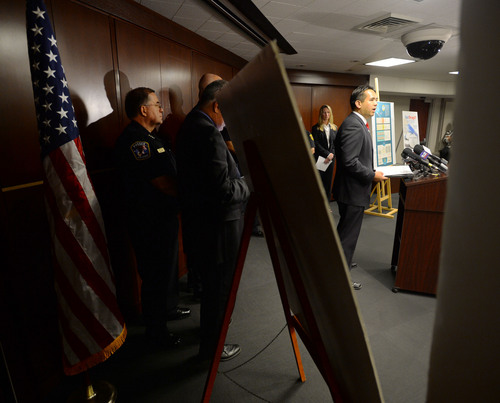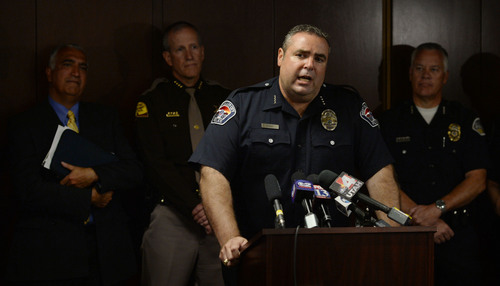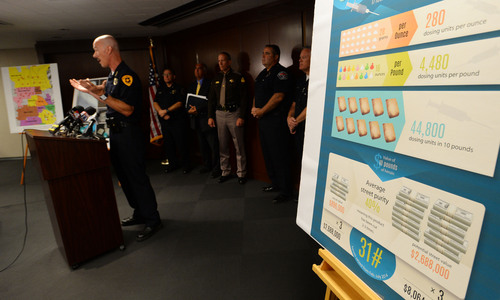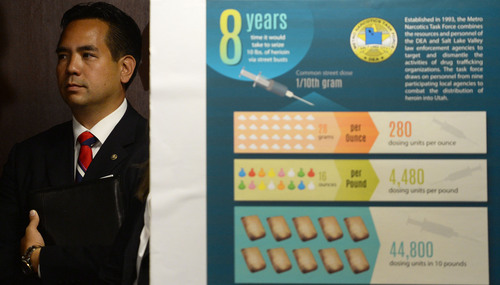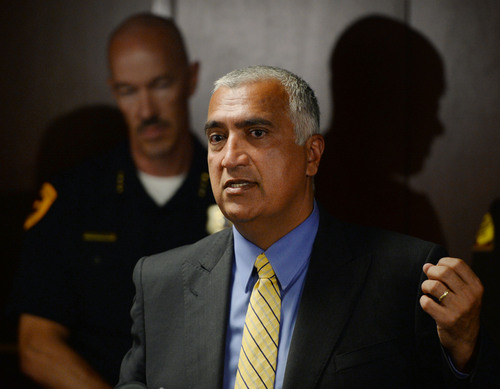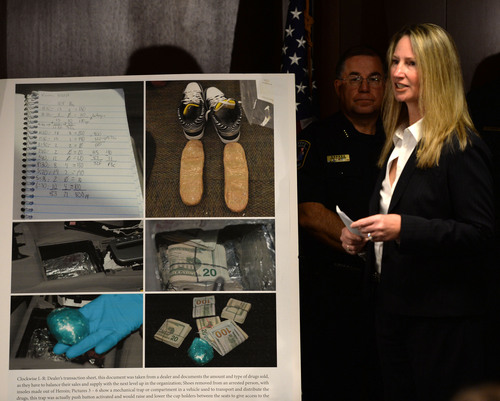This is an archived article that was published on sltrib.com in 2014, and information in the article may be outdated. It is provided only for personal research purposes and may not be reprinted.
Utah officers have seized 31 pounds of heroin in Salt Lake County since April, putting a dent in the rising tide.
The Metro Narcotics Task Force, made up of officers from nine local agencies, announced their success against the Mexican cartel-supported enterprise Thursday, including the arrests of 21 people, with more on the way. To give a scope of the victory, Salt Lake City Police Chief Chris Burbank pointed to a chart explaining how it would have taken street-level busts a quarter century to seize 31 pounds, and such an amount represents 138,000 hits for abusers.
Yet, law enforcement leaders acknowledged that the disruption is only that; the growing scourge of heroin abuse, and the crimes that stem from it, is ever-present. Society has to take a holistic approach that reduces demand, while at the same time cuts off supply like this, said Salt Lake County District Attorney Sim Gill.
"There is no simple solution to this," Gill said. The criminal justice system needs to adopt research-based, data-driven approach that embraces treatment, not simply prosecution, Gill said.
"During the '80s, we went through this incredible resurgence of wanting to just lock everybody up. And as a result of this, the United States of America jails more human beings than any other country in the world," Gill said following the press conference. "So when you look at the drug-related issues … what our research shows us, is that treatment reduces recidivism rates by over 50 percent. And it's cheaper to do it, we're not using the most expensive lock-up facility, and we're actually addressing the issue of demand."
Heroin began to spike as following a crack down on prescription drug abuse, since heroin provides a cheaper alternative to pills, Gill said. First-time users nearly doubled in a six-year period ending in 2012, from 90,000 to 156,000. In 2012, the greatest increases were among those 18 to 25.
"The heroin trade is active and robust," said Attorney General Sean Reyes, adding that the cheap drug can be "easier to obtain than a pizza."
Bank robberies tripled in Salt Lake County in the past two years, and in looking back at the suspects for the past year to year-and-a-half, 88 percent of them were heroin addicts, Burbank said. He also acknowledged that there is a risk of property crimes, such as car prowls and burglaries, escalating in response to this bust.
"That is the risk that we run," Burbank said.
It's no accident that the Wasatch Front has seen a resurgance in heroin use, given its "plethora" of prescription fraud, Gill said. "We've had an incredible amount of opiate addictions that occur, and we need to educate our citizens and we need to make sure that we're controlling and monitoring when we're dispensing these medicines out."
While dealing with the addicts' issues is important, Thursday's announcement is meaningful too because it's important to hit the large supplies, Gill said. The chart at the press conference detailed how 31 pounds of heroin could have translated to about $2.6 million in profits for the distributors. Gill said his office has been filing distribution, money laundering and racketeering charges against the suspects.
"All of these issues, although they can be looked in and stand-alone, they're interconnected, they're symbiotically connected as a systems approach, and you have to start hitting all aspects of the process if we're going to make a communal gain," Gill said. "Otherwise, we're just throwing good money after bad efforts, and we're going to lose in the end."
The Associated Press contributed to this story.
Twitter: @mikeypanda



